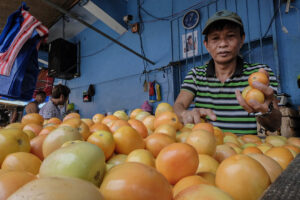The Agrarian Reform Law is one of the most controversial and divisive laws ever enacted in the Philippines. It required the martial law powers of President Ferdinand Marcos, Sr. and the popularity of President Corazon Aquino to have it passed and expanded.
From the time it was crafted and proposed, the Law had invited scores of detractors. Moreover, the volume of criticism and hostility toward it accelerated in step with the continued subpar performance of the agriculture sector.
One is tempted to ask: was the Agrarian Reform Law a mistake? And more importantly, why was it legislated in the first place? To answer those questions requires looking back at our nation’s history and the antecedents that led to the passage of this landmark piece of legislation.
A BRIEF HISTORY OF LAND OWNERSHIP IN PHLDuring the pre-Spanish period, there was no such thing as private land ownership. It was unnecessary because land was plentiful, and we had a sparse population. What was practiced then was communal farming and tribal land control.
When the Spaniards arrived, they introduced the encomienda system or the Royal Land Grant. Huge tracts of land were distributed to the different religious orders and certain favored individuals, who were deemed to have rendered invaluable service to the Crown. As a consequence, from having the freedom to cultivate their land unimpeded, the natives (our ancestors and later their descendants) were now obligated to do forced labor and surrender a substantial portion of the income from the land they tilled to the encomenderos.
Later on, when the barangays were consolidated into municipios, cabezas and gobernadorcillos were appointed to administer and collect taxes. Many of them took advantage of their positions to acquire more land and amass political power. They became abusive landowners to their tenants. As a result, they gained the notorious label of caciques or political bosses.
When the Americans took over the reins of government, the plight of the tenant-farmers remained unchanged. No substantive reforms were introduced.
Finally, when we gained our independence, the role of the encomenderos and caciques was taken over by the local oligarchs.
The main goal of agrarian reform, therefore, was not necessarily to improve the lands’ productivity, although that was in the cards, but rather to dispense social justice. The lands that were unjustly taken away from the natives were to be given back to their descendants to end their centuries-old exploitation.
FAST FORWARD TO THE PRESENTThe opposition’s main argument against agrarian reform is that it fragmented our agricultural lands into small plots. They said this hindered the use of modern machinery and equipment, and the application of advanced farm technology and management, and created diseconomy of scale. All of these factors resulted in low farm productivity and inefficiency. The critics’ reasoning seemed solid and well-founded, but are they infallible?
When Israel’s agricultural experts visited the country a few months back (Israel is a top-notch agriculture-producing nation), they were asked in a forum, “What is the minimum size for an agricultural land to become viable?” The answer was quite revealing. “Size doesn’t matter. Even a land area of 400 square meters or less can be commercially successful for as long as enough investments and the appropriate technology are inputted into the project,” they said.
Now, there’s the rub. Our farms are underperforming because the farmers don’t have enough capital to invest while the government’s assistance is just a pittance.
Several years ago, a Filipino delegation went to Taiwan to observe and learn from a cooperative there. The members of the coop were into high-value vegetable crop production using advanced technology, like greenhouse infrastructure, drip irrigation, etc. They also applied modern processing and packaging in their trading business. The average area owned by each farmer was less than a hectare, with many owning half a hectare. What was fascinating is that the coop’s members are all millionaires!
The above scenarios clearly showed that in agriculture, bigness as a requisite for success is a myth. It has been perpetuated by some economists who were so enamored with the concept of economies of scale that they have discarded the notion that small could also be beautiful. Sure, for certain crops like palm oil and rubber, or integrated farms consisting of various produce, economies of scale are a huge advantage. But not in all crops. The point is, if your land area is small, then choose a suitable crop and apply the appropriate technology, and you could still be successful.
Let’s analyze a specific crop, like rice for example, which is currently planted in small plots for its production. Agrarian reform reduced the size of our average rice farms to 1.3 hectares with an average yield of 4.17 metric tons per hectare. Meanwhile, the best rice-producing farmer in Southeast Asia, the Vietnamese, has an average farm size of only 0.5 hectare and yet has an average yield of six metric tons per hectare. So where are the economies of scale there?
Of course, contributing to Vietnam’s high rice yield is the mighty Mekong River, which helps in irrigating their farms. But since there are new emerging rice varieties that need less water to produce, we should be able to compete with them. In addition, we actually have more than enough rainfall to properly irrigate our farms. We just aren’t wise enough to harness the water by way of constructing catch basins, sabo dams, etc.
Other rice-producing countries in the region have similar average farmland size as we do, with the Asian average being one hectare. In terms of rice crops, therefore, there is no valid argument that the Agrarian Reform Law disadvantaged our farmers from competing with their Asian counterparts.
Lastly, if we consolidate and convert our rice farms into huge plantations, the risk is that we might suffer an even worse rice shortage than what we are experiencing now. Because then, the land would become viable for planting to other crops. Why plant rice, a political commodity whose price is heavily controlled by the government by way of importation, when the land could already support other crops whose earning potential is higher?
There are many factors contributing to our dismal agricultural performance, but agrarian reform is not the main culprit.
In summary, all this talk about agrarian reform is water under the bridge; it is meaningless because the Law is already written in stone. We cannot take back the lands that have already been distributed without courting agrarian unrest, if not outright rebellion. The best we could do is to make it work, notwithstanding its perceived inadequacies.
This article reflects the personal opinion of the author and does not reflect the official stand of the Management Association of the Philippines or MAP.
Edgardo “Ed” C. Amistad is a member of the MAP Agribusiness Committee. He is an adviser of the Philippine Disaster Resilience Foundation and former president of the UCPB-CIIF Finance and Development Corp. and the UCPB-CIIF Foundation.















